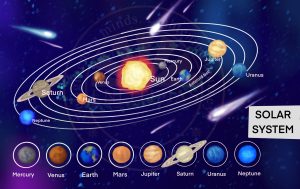Planets in Solar System
- Our Solar System consists of the sun and eight planets (Mercury, Venus, Earth, Mars, Jupiter, Saturn, Uranus, Neptune) which are placed in the Milky Way Galaxy.
Classification Planets in Solar System
- Inner Planets
- Mercury
- Mercury is closest to the sun.
- It has a temperature range of 427ºC on its side facing the Sun and – 270ºC, on its dark side.
- It has no atmosphere.
- Mercury is smaller than the largest natural satellite in the Solar System, Ganymede (largest moon of Jupiter).
- Venus
- It is the closest neighbour of the earth.
- It is the hottest planet with a temperature of 480ºC because the atmosphere has 96% carbon dioxide and poisonous gases like sulphur dioxide and carbon monoxide.
- It is the third brightest object visible from the earth after the sun and the moon.
- It is the brightest among planets because it has the highest albedo due to the highly reflective sulfuric acid that covers its atmosphere.
- Venus is sometimes called Earth’s sister planet or Earth’s twin because of their similar size, mass, proximity to the Sun, bulk composition and presence of similar physical features.
- It rotates in the opposite direction (clockwise) to most other planets.
- Earth
- Earth is the only planet known to sustain life.
- Mars
- It is called the Red Planet because of the reddish iron oxide prevalent on its surface.
- It has 95% carbon monoxide and reddish dust.
- It is relatively a very cold planet.
- Mercury
- Outer Planets
- Jupiter
- It is the largest planet in the solar system.
- It is mainly a rapidly spinning ball of gas, especially clouds of ammonia, and has no solid surface.
- Jupiter’s four large moons (Io, Europa, Ganymede, and Callisto) are called the Galilean satellites because Galileo discovered them.
- Saturn
- It consists mainly of hydrogen and helium.
- Saturn’s density is even lesser than water.
- Its rings are made up of billions of ice particles and ice-covered rocks.
- Titan is its largest satellite.
- Uranus
- It is also a very cold planet.
- Uranus is a distant planet of the solar system and 7th in order from the sun.
- Uranus and Neptune are the outermost planets of the solar system.
- Uranus has a highly tilted rotation axis.
- Neptune
- Neptune is cold and dark with its surface coated with frozen methane.
- It is the furthest of the planets in our solar system.
- It is more than 30 times as far from the sun as Earth is.
- Neptune is very similar to Uranus. It’s made of a thick fog of water, ammonia, and methane over an earth-sized solid centre.
- Its atmosphere is made of hydrogen, helium, and methane.
- Jupiter

Difference Between Inner Planets and Outer Planets
|
|
|
|
|
|
|
|
|
|
|
|
Moon
- The Moon is Earth’s only natural satellite.
- At about one-quarter the diameter of Earth, it is the fifth largest satellite in the Solar System.
- It is in synchronous rotation with Earth meaning the same side is always facing the Earth.
- The Moon revolves around the Earth in 27 days 7 hours 43 minutes and 11.47 seconds and rotates on its own axis at the same time. That is why only one face of the Moon is seen from Earth, as its rotation period as well as revolution period are nearly the same.
Comets
- Comets are icy frozen gases (water, ammonia, methane, and carbon dioxide) that hold together small pieces of rocky and metallic minerals.
- They have highly elliptical orbits, unlike the planets which have near-circular orbits.
- Short-period comets, with an orbital period of a few hundred years, originate in the Kuiper belt. Longer period comets, with orbits of thousands of years, come from the more distant Oort Cloud.
